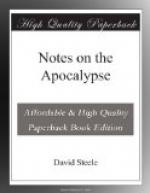CHAPTER XII.
1. And there appeared a great wonder in heaven: a woman clothed with the sun, and the moon under her feet, and upon her head a crown of twelve stars;
2. And she, being with child, cried, travailing in birth, and pained to be delivered.
Vs. 1, 2.—The Apocalypse, besides the three parts into which it is divided by its divine Author, (noticed in ch. i. 19,) is also susceptible of division into two parts. With the eleventh chapter terminates the abridged prospective history of the church and of the world, emblematically represented under the seals and trumpets. The seventh seal, when opened, disclosed all the contents of the sealed book, and also introduced the seven trumpets. But we have followed the series of the trumpets in order, to the end of the world,—interrupted only by the isolated history of the “little book; which, treating of events which were matter of history under the first two woe-trumpets, could not be sealed. Now at the twelfth chapter, without regard to the seventh, or any other of the trumpets in particular, we are furnished with a second and enlarged edition, as it were, of the most important parts of the first edition. We have observed before, that this is the manner of the prophets on a large scale, especially in predicting “the sufferings of Christ, and the glory that should follow.” So it is with John and Paul. What the latter only hints at, when writing to Timothy, (1 Tim. iv. 1-3,) he enlarges upon in addressing the Thessalonians. (2 Thess. ii. 3-12.) The theme is the same as treated by these two apostles; and this coincidence will in due time be more manifest. Next to Christ personal, the prophets have been interested in the destiny of Christ mystical.
Three different views of this twelfth chapter have been taken by the more sober and learned expositors. One considers it as referring to the Roman empire in its heathen state, prior to the time of Constantine. Another understands the first part of this chapter,—(vs. 1-6,)—as relating to Rome pagan, and the rest of the chapter to antichristian Rome. A third conceives that the whole of it applies to apostate imperial Rome only. The last is doubtless the correct view.
As the “sealed book” and the “little open book,” must be supposed to contain all the prophetical part of the Apocalypse; and as the whole of the little book is comprised in the eleventh chapter, (vs. 1—13,) this twelfth chapter must belong to the sealed book. Being a continuance of the history under the seventh seal, although it may agree in time with some of the trumpets, it cannot go back to a period prior to the seventh seal. But under the sixth seal, paganism was abolished in the Roman empire; therefore this chapter refers to the antichristian empire. Moreover, as the little book was introductory to the seventh trumpet, designating the object of the third woe, so this chapter and the next two, are wholly occupied in describing the object of the vials, (ch. 16.)




